Develop: Insert & Delete Data Save
Estimated reading time: 78 minutesOverview
In this example you will modify the previous Editing Data Save, which was set up to edit a customer's contact name and title. In this Insert & Delete Data Save, you will walkthrough the steps to edit all the columns. In addition, you will also include the ability to insert or delete a customer from within the Excel report.
Note: The Customer Aging Report used in this example is a report that displays a customer's outstanding balances. It is not normally used to edit, insert, or delete a customer directly. However, for this walkthrough demonstration purpose, you will modify the report in order to do so.
This walkthrough involves 6 main steps:
- Set up a Data Connection (completed already)
- Set up a Data Portal
- Setting up the report to handle the save
- Setting up the soft delete
- Set up the Stored Procedure (SP) to handle the save
- Test the Stored Procedure & ReportSave
Note: This example uses Microsoft's Northwind Database. To download a minimized copy of the Northwind database for use in these labs, see here.
Setting Up the Data Connection
For the Data Connection for this example, you will use the connection previously set up here.
Setting Up the Data Portal
Step 1: Navigate to https://portal.gointerject.com and log in. Click on Data Portals on the left side bar and then the NEW DATA PORTAL button.
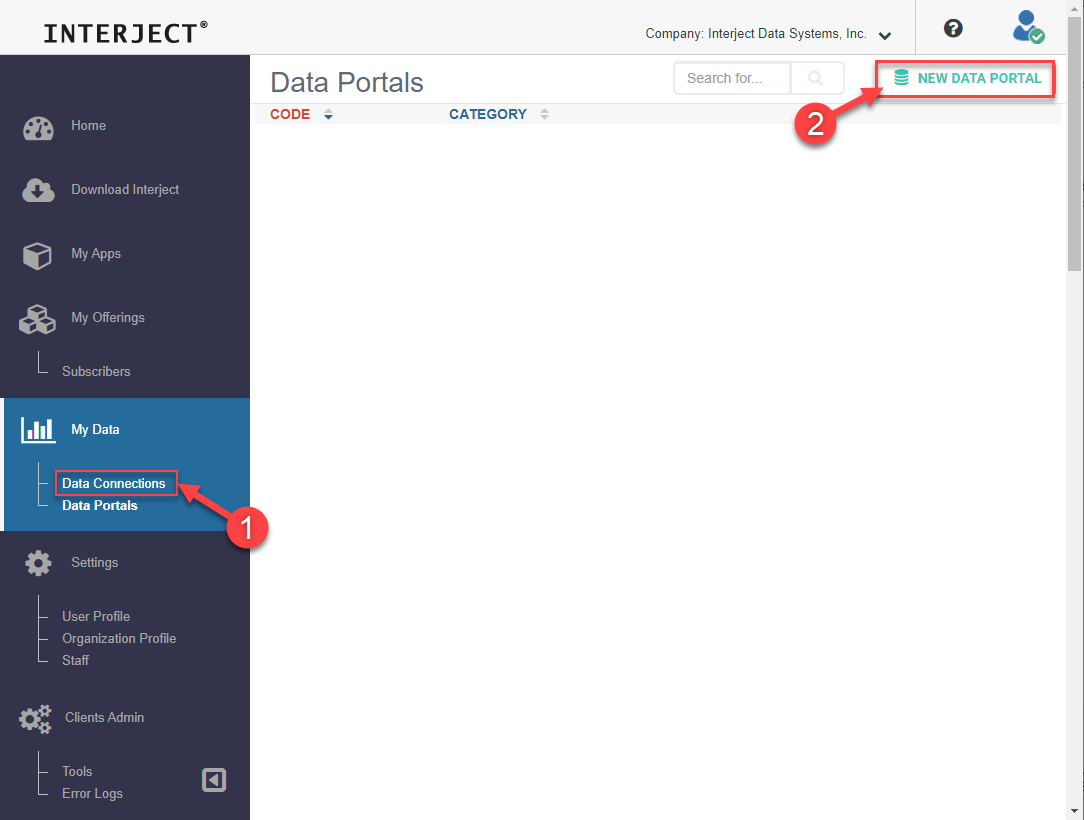
Step 2: Enter the following details on setting up the new data portal and click "CREATE DATA PORTAL".
- Data Portal Code: NorthwindInsertDeleteDataSave
- Description: Data portal for insert and delete data save
- Category: Demo
- Connection: NorthwindExampleDB_MyName (replace "MyName" with your name)
- Command Type: Stored Procedure
- Stored Procedure/Command: NorthwindInsertDeleteDataSaveSP
Note: You will create the "NorthwindInsertDeleteDataSaveSP" Stored Procedure later

Step 3: After creating the data portal, scroll down and click Click here to add a System Parameter and ensure the Interject_RequestContext parameter is set.
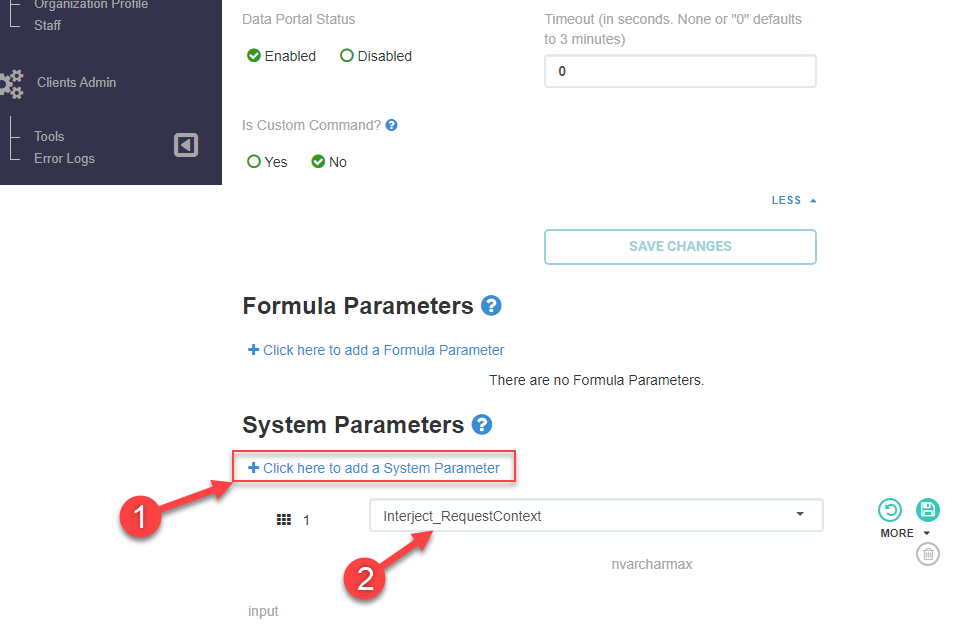
The System Parameter Interject_RequestContext will transfer contextual data to the Stored Procedure you will set up later. In this example you will not need this info but it is a good practice to set this parameter for all your Stored Procedures.
Setting Up the Report
Begin by opening up the report that was completed in the previous data save. You will modify this report to set up the Insert & Delete Data Save.
Step 1: First click on the cell containing the ReportSave function and change it to match the Data Portal you just set up:
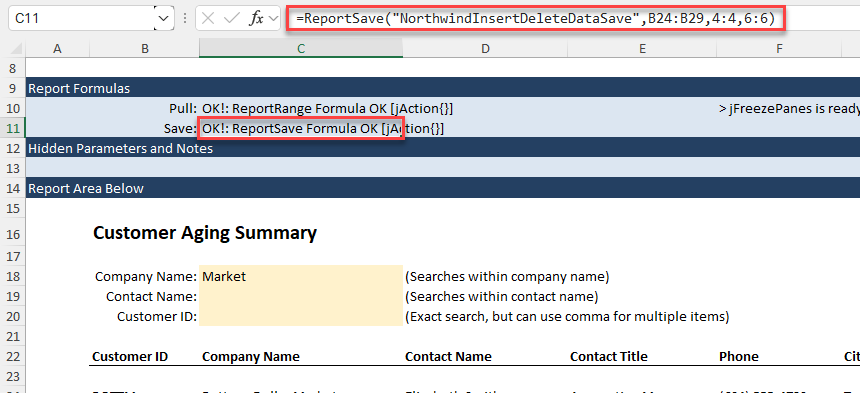
Step 2: Next add the CompanyName, Phone, City, Country and Delete to the "Column Definition - Save" configuration row so that this data will be saved to the data source:

Step 3: Next you will add a Delete? column to the report. This way if there is a "Yes" marked in this column, the record for that row will be deleted. This prevents the accidental deletion of records if they are missing from the report:

Highlight the cells on the new Delete? column and click Data Validation to bring up the Data Validation window:

For the Validation criteria, click on List for the Allow field and enter Yes for the Source:
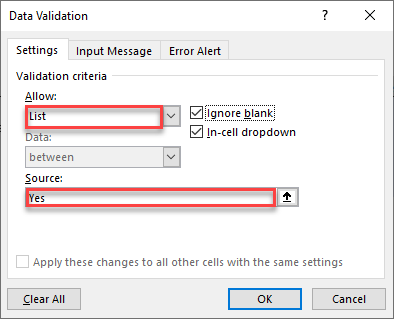
Step 4: Finally, enter [clear] into cell N2 in order for the entries in the Delete column to be cleared out on a pull.

That's it. The report is now ready to add, delete, or update a customer.
Setting Up the Soft Delete
There are two main ways to delete a record from a database: a hard delete and a soft delete. A hard delete simply removes the record from the database altogether. A soft delete simply flags the record as deleted. This approach is preferable over a hard delete because you can recover the data easily by switching the flag. The example in this data save uses a soft delete. In order to implement this, you will need to set up a column in the targeted data table that will store a IsDeleted BIT value to distinguish which records have been soft deleted.
Step 1: Execute the following SQL to add a IsDeleted column to the table that you are saving to:
ALTER TABLE dbo.Northwind_Customers
ADD IsDeleted BIT
Step 2: Now that the new column has been added, you need to set all the existing values to 0. Execute the following SQL on the same table:
UPDATE dbo.Northwind_Customers SET IsDeleted = 0
Step 3: Next, since you don't want to allow nulls for this flag, set the IsDeleted column to "Not Null" by executing the following SQL:
ALTER TABLE dbo.Northwind_Customers
ALTER COLUMN IsDeleted BIT NOT NULL
Step 4: Lastly, in order to only pull records that are not deleted, you will need to add the following line to the Stored Procedure previously set up that pulls the data for this report:
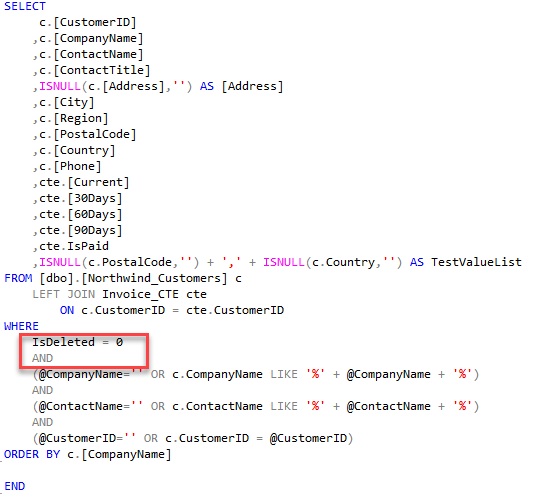
Setting Up the Stored Procedure
Next you will created a new Stored Procedure that builds from the previous save. To make this easier, simply copy the SP into a new query, change the command to "CREATE OR ALTER PROC NorthwindInsertDeleteDataSaveSP" and execute it to save it. Then you can begin making modifications to it. For your convenience, the SP is posted here.
Note: The code for testing the SP has been removed. It will be handled later
CREATE OR ALTER PROC [dbo].[NorthwindInsertDeleteDataSaveSP]
-- System Params not in formula
@Interject_RequestContext nvarchar(max)
,@TestMode bit = 0 -- used only for testing the stored procedure directly. It will show more results when set to 1.
AS
/*
==================================================================================
CREATED DATE: 3/7/2023 8:22 AM
CREATED BY: Interject Default
DESCRIPTION: Example data pull to be used with Interject
---------------------------------------------------------------------------
TEST Example: Use the below to test this stored procedure:
---------------------------------------------------------------------------
This section has been removed. To get sample code for testing this stored procedure,
select the cell in Excel containing the ReportSave function. Then click on the Interject
ribbon, click System > View SQL Test For ActiveCell.
---------------------------------------------------------------------------
Validation Example:
---------------------------------------------------------------------------
Note: By adding 'UserNotice:' to the error message, Interject will show the message in an alert box and not flag the formula with an error.
Without it, the formula will show an error with the text the user can click into.
IF @ParameterName = 'TheWrongValue'
BEGIN
RAISERROR ('UserNotice:You selected an invalid value. Unable to continue.',
18, -- Severity,
1) -- State)
RETURN
END
---------------------------------------------------------------------------
Reserved Parameters:
---------------------------------------------------------------------------
Note: If the below parameters are added to your stored procedure and to the
data portal parameter list, Interject will pass the related value automatically.
@Interject_XMLDataToSave varchar(max) - Required for saving data. It contains XML for the designated cells values.
@Interject_ColDefItems varchar(max) - Provides the Column Definitions in XML designated within the report formula.
@Interject_RowDefItems varchar(max) - Provides the Row Definitions in XML designated within the report formula.
@Interject_SourceFileAndPath varchar(500) - Provides the path and file name delimited by '|' of the current file.
@Interject_SourceFilePathAndTab varchar(1000) - Provides the path, file name and active tab name delimited by '|' of the current file.
@Interject_LocalTimeZoneOffset money - Provides a number (0.000) that represents the offset of the users time to UTC time.
@Interject_NTLogin varchar(50) - Provides the user's computer login name for their current session.
@Interject_UserID varchar(50) - Provides the Interject User ID for their current session.
@Interject_LoginName varchar(50) - Provides the Interject Full name for their current session.
@Interject_ExcelVersion varchar(50) - Provides the users Excel version.
@Interject_UserRoles varchar(1000) - Provides the Interject roles assigned to the user.
@Interject_ClientID varchar(50) - Provides the Interject Client ID for their current session.
@Interject_ReturnError varchar(2000) - Is an output parameter that can be used to return an error back to the user. Pass empty string for no error.
@Interject_RequestContext nvarchar(max) - Provides all above request context and both the open text and encrypted version of the user context.
==================================================================================
*/
--
-- Use helper to extract data from Interject_RequestContext. Remove items that are not needed
-- The helper stored procedure [dbo].[RequestContext_Parse] is required for this section to function
--
DECLARE
@ExcelVersion NVARCHAR(100)
,@IdsVersion NVARCHAR(100)
,@FileName NVARCHAR(1000)
,@FilePath NVARCHAR(1000)
,@TabName NVARCHAR(1000)
,@CellRange NVARCHAR(100)
,@SourceFunction NVARCHAR(100)
,@UtcOffset DECIMAL(6,4)
,@ColDefItemsDelimited xml
,@ResultDefItemsDelimited xml
,@RowDefItemsDelimited xml
,@MachineLoginName NVARCHAR(100)
,@MachineName NVARCHAR(100)
,@Interject_UserID NVARCHAR(100)
,@Interject_ClientID NVARCHAR(100)
,@Interject_LoginName NVARCHAR(100)
,@Interject_LoginAuthTypeID INT
,@Interject_LoginDateUTC DATETIME
,@Interject_UserRolesDelimited NVARCHAR(max)
,@UserContextEncrypted NVARCHAR(4000)
,@Interject_XMLDataToSave xml
EXEC [dbo].[RequestContext_Parse]
@Interject_RequestContext = @Interject_RequestContext
,@ExcelVersion = @ExcelVersion OUTPUT
,@IdsVersion = @IdsVersion OUTPUT
,@FileName = @FileName OUTPUT
,@FilePath = @FilePath OUTPUT
,@TabName = @TabName OUTPUT
,@CellRange = @CellRange OUTPUT
,@SourceFunction = @SourceFunction OUTPUT
,@UtcOffset = @UtcOffset OUTPUT
,@ColDefItemsDelimited = @ColDefItemsDelimited OUTPUT
,@ResultDefItemsDelimited = @ResultDefItemsDelimited OUTPUT
,@RowDefItemsDelimited = @RowDefItemsDelimited OUTPUT
,@MachineLoginName = @MachineLoginName OUTPUT
,@MachineName = @MachineName OUTPUT
,@Interject_UserID = @Interject_UserID OUTPUT
,@Interject_ClientID = @Interject_ClientID OUTPUT
,@Interject_LoginName = @Interject_LoginName OUTPUT
,@Interject_LoginAuthTypeID = @Interject_LoginAuthTypeID OUTPUT
,@Interject_LoginDateUTC = @Interject_LoginDateUTC OUTPUT
,@Interject_UserRolesDelimited = @Interject_UserRolesDelimited OUTPUT
,@UserContextEncrypted = @UserContextEncrypted OUTPUT
,@Interject_XMLDataToSave = @Interject_XMLDataToSave OUTPUT
IF @TestMode = 1
BEGIN
SELECT
@ExcelVersion as '@ExcelVersion'
,@IdsVersion as '@IdsVersion'
,@FileName as '@FileName'
,@FilePath as '@FilePath '
,@TabName as '@TabName'
,@CellRange as '@CellRange'
,@SourceFunction as '@SourceFunction'
,@UtcOffset as '@UtcOffset'
,@ColDefItemsDelimited as '@ColDefItemsDelimited'
,@ResultDefItemsDelimited as '@ResultDefItemsDelimited'
,@RowDefItemsDelimited as '@RowDefItemsDelimited'
,@MachineLoginName as '@MachineLoginName'
,@MachineName as '@MachineName'
,@Interject_UserID as '@Interject_UserID'
,@Interject_ClientID as '@Interject_ClientID'
,@Interject_LoginName as '@Interject_LoginName'
,@Interject_LoginAuthTypeID as '@Interject_LoginAuthTypeID'
,@Interject_LoginDateUTC as '@Interject_LoginDateUTC'
,@Interject_UserRolesDelimited as '@Interject_UserRolesDelimited'
,@UserContextEncrypted as '@UserContextEncrypted'
,@Interject_XMLDataToSave as '@Interject_XMLDataToSave'
END
DECLARE @ErrorMessageToUser as varchar(1000) = ''
--
-- PROCESS THE XML DATA INTO TABLE VARIABLE
-- varchar(max) is used for the data type by default. Please change for the specific requirement.
--
DECLARE @DataToProcess TABLE
(
-- the below are system values used internally in this stored procedures
[_ExcelRow] INT
,[_MessageToUser] VARCHAR(500) DEFAULT('')
-- Below are your columns expected from the spreadsheet that is calling this save stored procedure
-- Please change the (max) to the expected length of the text input. If limiting length, be sure to make the size larger than allowed so you can add validation to notify the user
,[CustomerID] NCHAR(5)
,[ContactName] NVARCHAR(30)
,[ContactTitle] NVARCHAR(30)
)
IF DATALENGTH(@Interject_XMLDataToSave) > 0
BEGIN
declare @DataToProcessXML as XML
-- Handle conversion of XML text into an XML variable.
BEGIN TRY
SET @DataToProcessXML = CAST(@Interject_XMLDataToSave as XML)
END TRY
BEGIN CATCH
SET @ErrorMessageToUser = 'Error in Parsing XML from Interject. Error: ' + ERROR_MESSAGE()
GOTO FinalResponseToUser
END CATCH
-- Insert the XML into the table variable for further processing
INSERT into @DataToProcess(
[_ExcelRow]
-- The below columns are provided based on your column definitions in the ReportSave() function]
,[CustomerID]
,[ContactName]
,[ContactTitle]
)
SELECT
-- The below row value is always provided by Interject
T.c.value('./Row[1]', 'INT') as [_ExcelRow]
-- The below columns are provided based on your column definitions in the ReportSave() function
,T.c.value('./CustomerID[1]', 'NCHAR(5)') as [CustomerID]
,T.c.value('./ContactName[1]', 'NVARCHAR(30)') as [ContactName]
,T.c.value('./ContactTitle[1]', 'NVARCHAR(30)') as [ContactTitle]
FROM @DataToProcessXML.nodes('/XMLDataToSave/r') T(c)
END
-- TestMode is provided so a test save can be executed and all related data can be
-- easily viewed for testing while not effecting any data in the database
IF @TestMode =1
BEGIN
SELECT '@DataToProcess - After XML Processing' as ResultName
SELECT * FROM @DataToProcess
END
--
-- VALIDATION SECTION - Ensure inputs received from Excel are valid
--
-- Validate that the details do not have duplicates on the primary key
UPDATE m
SET [_MessageToUser] = [_MessageToUser] + ', Duplicate key'
FROM @DataToProcess m
INNER JOIN
(
SELECT [CustomerID]
FROM @DataToProcess
WHERE [CustomerID] <> ''
GROUP BY [CustomerID]
HAVING COUNT(1) > 1
) as t
ON
m.CustomerID = t.CustomerID
-- Now check if there were any validation issues in the detail and stop processing if true
IF EXISTS(SELECT 1 FROM @DataToProcess WHERE [_MessageToUser] <> '')
BEGIN
SET @ErrorMessageToUser = 'There were errors in the details of your input. Please review the errors noted in each row.'
GOTO FinalResponseToUser
END
--
-- DATA UPDATE
--
BEGIN TRY
-- this table variable will log the changes to the target table so it can be used
-- to return helpful feedback to the user about how the save action resulted
DECLARE @ChangeLog as TABLE
(
[_ExcelRow] INT -- will capture the source row that affected the target table
,[UpdateTypeCode] VARCHAR(10) -- Will show UPDATE, INSERT, or DELETE
,[CustomerID] NCHAR(5)
)
BEGIN TRAN t1
--
-- use MERGE statement that UPDATES, INSERTS, and DELETES in one action
--
MERGE dbo.Northwind_Customers t -- t = the target table or view to update
USING (
SELECT
[_ExcelRow]
,[CustomerID]
,[ContactName]
,[ContactTitle]
FROM @DataToProcess
) s -- s = the source data to be used to update the target table
-- the join on the column keys is specified below
ON
s.[CustomerID] = t.[CustomerID]
WHEN MATCHED -- Handles the update based on INNER JOIN
AND NOT
(
s.[ContactName] = t.[ContactName] -- To ensure only changes are captured
AND
s.[ContactTitle] = t.[ContactTitle]
)
THEN
UPDATE SET
t.[ContactName] = s.[ContactName]
,t.[ContactTitle] = s.[ContactTitle]
--WHEN NOT MATCHED BY TARGET THEN -- Handles the insert based on LEFT JOIN -- NOT USED IN THIS EXAMPLE
-- INSERT([ExampleColumnKey],[ExampleColumnValue])
-- VALUES(s.ExampleColumnKey],s.[ExampleColumnValue])
--WHEN NOT MATCHED BY SOURCE -- Handles the delete based on the RIGHT JOIN -- NOT USED IN THIS EXAMPLE
-- AND... add restrictions so delete doesn't remove too much. Filter params are normally considered here.
-- THEN
-- DELETE
-- the output captures the changes to the table and logs to a table variable
OUTPUT
isnull(inserted.[CustomerID],deleted.[CustomerID]) -- include deleted in case delete is added later. Inserted is used for both Update an Insert
,s.[_ExcelRow]
,$action as UpdateTypeCode -- this logs into an a change log table variable
INTO @ChangeLog
(
[CustomerID]
,[_ExcelRow]
,[UpdateTypeCode]
);
--now we have enough information to update the message to user for each row
UPDATE dtp
SET [_MessageToUser] =
CASE cl.UpdateTypeCode
--WHEN 'INSERT' THEN ', Added!' -- not used in this example
--WHEN 'DELETE' THEN ', Deleted' -- this will never match the excel side but can be used for other types of logging
WHEN 'UPDATE' THEN ', Updated!'
--ELSE ', No change' -- not used in this example
END
FROM @DataToProcess dtp
INNER JOIN @ChangeLog cl -- use Left Join if 'No Change' is to be identified
ON dtp.[_ExcelRow] = cl.[_ExcelRow]
IF @TestMode = 1
BEGIN
SELECT '@ChangeLog- Show log of changes made' as ResultName
select * from @ChangeLog
ROLLBACK TRAN t1 -- note this does not roll back changes to table variables, only real tables
SELECT 'Changes rolled back since in TEST mode!' as TestModeNote
END
ELSE
BEGIN
COMMIT TRAN t1
END
END TRY
BEGIN CATCH
IF @@TRANCOUNT > 0
ROLLBACK TRAN t1
SET @ErrorMessageToUser = ERROR_MESSAGE()
GOTO FinalResponseToUser
END CATCH
FinalResponseToUser:
--
-- PROVIDE RESPONSE TO THE SAVE ACTION
--
-- if test mode, show the final table
IF @TestMode = 1
BEGIN
SELECT '@DataToProcess - After Validation' as ResultName
SELECT * FROM @DataToProcess
END
-- return the recordset results back to the spreadsheet, if needed.
SELECT
[_ExcelRow] as [Row] -- this relates to the original row of the spreadsheet the data came from
,SUBSTRING([_MessageToUser],3,1000) as [MessageToUser] -- This is a field that, if it matches a column in the Results Range, will be placed in that column for the specified row
FROM @DataToProcess
-- if there is an error, raise error and Interject will catch and present to the user.
-- Note that this is specifically done after the above resultset is returned, since initiating an error before
-- will not allow a result set to be returned to provide feedback on each row
IF @ErrorMessageToUser <> ''
BEGIN
-- by adding 'UserNotice:' as a prefix to the message, Interject will not consider it a unhandled error
-- and will present the error to the user in a message box.
SET @ErrorMessageToUser = 'UserNotice:' + @ErrorMessageToUser
RAISERROR (@ErrorMessageToUser,
18, -- Severity,
1) -- State)
RETURN
END
Execute the above code to save the Store Procedure.
Modifying the Stored Procedure
The following walks you through the major sections of the code with instructions on the changes. Additions are marked in yellow.
Data to Process
Since you are going to be saving more columns of data back to the data source, you need to add these columns to the @DataToProcess table. Be sure to match the data type of the table you will be saving the data to.
You will also add a ToBeDeleted NVARCHAR column to capture the new Delete column you added previously. The ToBeDeleted BIT column is another column needed to be added. This column will be set to a default 0 (meaning not deleted). Both these columns will represent if the record should be deleted.
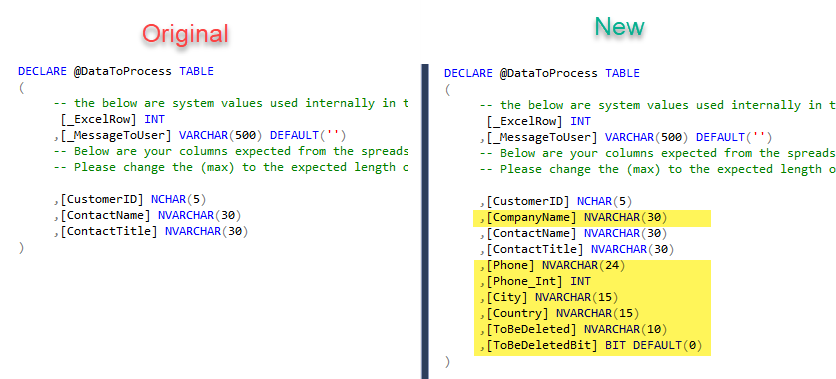
Inserting the Data to Process
Again, these additions are simply adding the additional columns so that they will be saved.
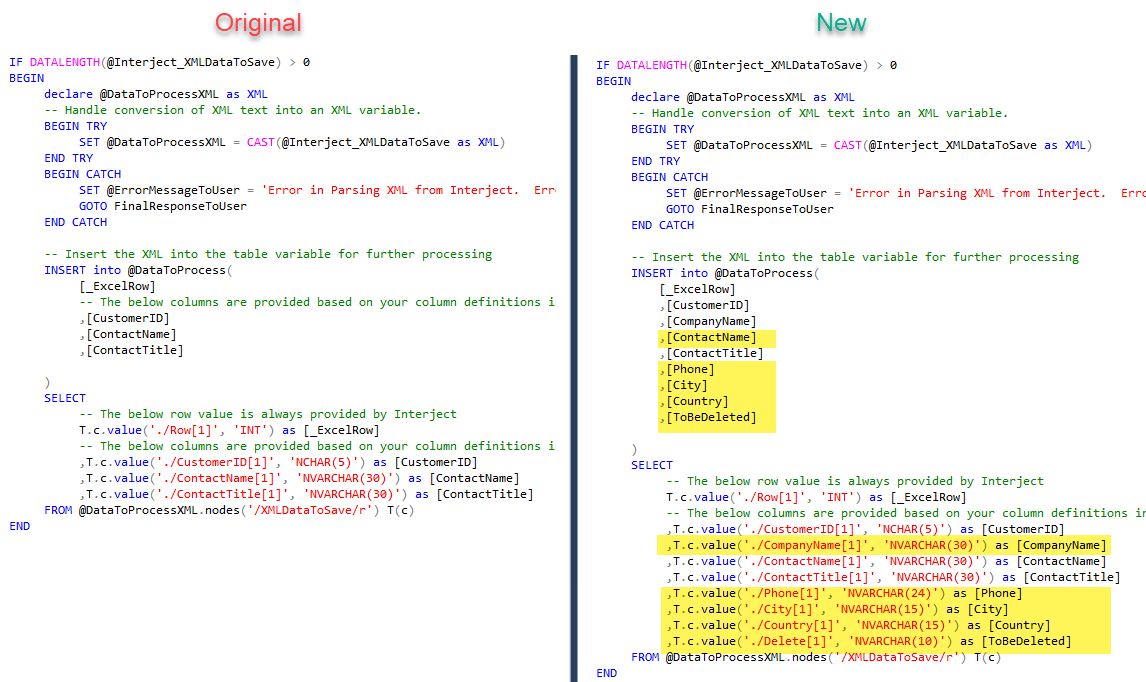
Update DataToProcess
This section will be added to store a BIT version of the ToBeDeleted NVARCHAR column in order for easier comparison later.

ChangeLog
Add the following 2 columns to the @ChangeLog table. They will capture the changes from in the IsDeleted column.
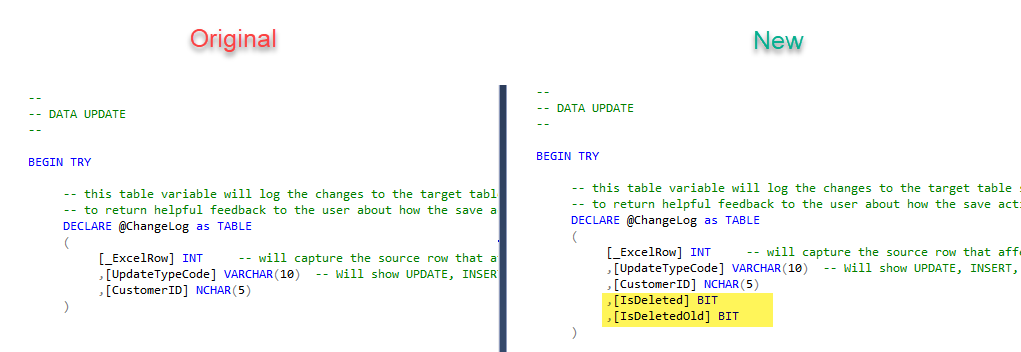
Merge Select
Next you will update the merge statement to include the additional columns to save:
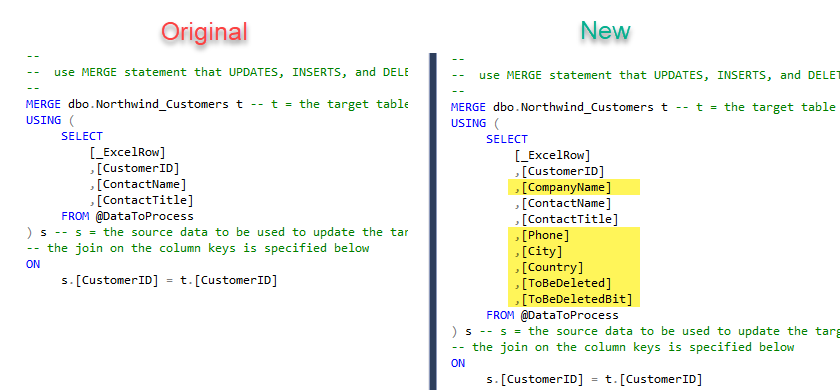
Merge Update
The "WHEN MATCHED" section handles updates to the data. It needs to be updated to add the additional columns. In addition, you will need to select both ToBeDeleted columns that were added earlier.
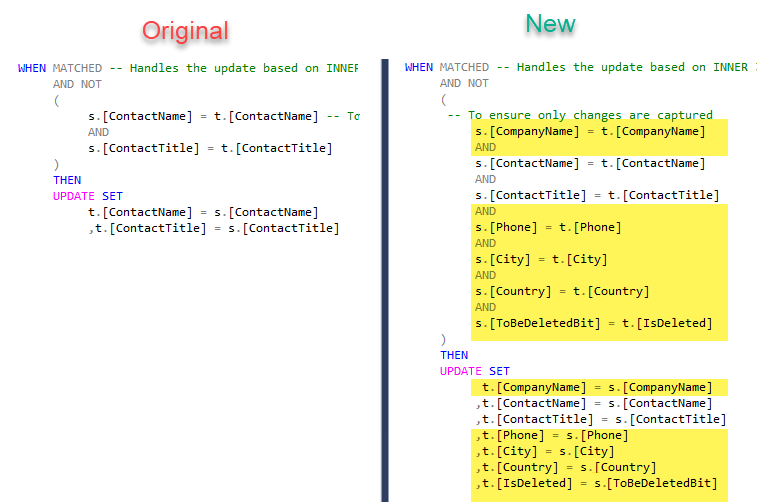
Merge Insert
Just after the previous section, you will add another section "WHEN NOT MATCHED BY TARGET". This will handle new insertions.
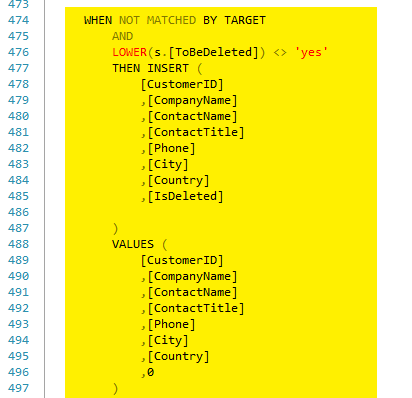
Merge Output
You will need to change the Merge Output to capture the changes in the IsDeleted column. The SQL Server keyword "inserted" captures what has been inserted with the Merge and "deleted" captures what was deleted. By included both values in the Output, you can determine how this column has changed. This will be required as explained in the next section.

Update ChangeLog
Because this SP is using a soft delete, any time a record is "deleted", the Merge statement will actually see it as an update because it is simply changing the IsDeleted column. Similarly, when the record is added back, it is another update. Thus there are 4 types of actions: Update, Update "Deleted", Update "Added Back", and Insert.
In order to distinguish between the different types of updates, you will need to change the UpdateTypeCode in the @ChangeLog table based on IsDeleted column. After the Output statement, add the following 2 update statements to set the correct type of action statement:

Set Message To User
The last piece of code that needs to be changed is setting the message to the user. You will simply add a few cases to handle the "Added Back", "Deleted", and "Inserted" cases:

Final Stored Procedure
Now that the Stored Procedure is finished, execute it to save it.
The following is the finished SP:
CREATE OR ALTER PROC [dbo].[NorthwindInsertDeleteDataSaveSP]
-- System Params not in formula
@Interject_RequestContext nvarchar(max)
,@TestMode bit = 0 -- used only for testing the stored procedure directly. It will show more results when set to 1.
AS
/*
==================================================================================
CREATED DATE: 3/7/2023 8:22 AM
CREATED BY: Interject Default
DESCRIPTION: Example data pull to be used with Interject
---------------------------------------------------------------------------
TEST Example: Use the below to test this stored procedure:
---------------------------------------------------------------------------
This section has been removed. To get sample code for testing this stored procedure,
select the cell in Excel containing the ReportSave function. Then click on the Interject
ribbon, click System > View SQL Test For ActiveCell.
---------------------------------------------------------------------------
Validation Example:
---------------------------------------------------------------------------
Note: By adding 'UserNotice:' to the error message, Interject will show the message in an alert box and not flag the formula with an error.
Without it, the formula will show an error with the text the user can click into.
IF @ParameterName = 'TheWrongValue'
BEGIN
RAISERROR ('UserNotice:You selected an invalid value. Unable to continue.',
18, -- Severity,
1) -- State)
RETURN
END
---------------------------------------------------------------------------
Reserved Parameters:
---------------------------------------------------------------------------
Note: If the below parameters are added to your stored procedure and to the
data portal parameter list, Interject will pass the related value automatically.
@Interject_XMLDataToSave varchar(max) - Required for saving data. It contains XML for the designated cells values.
@Interject_ColDefItems varchar(max) - Provides the Column Definitions in XML designated within the report formula.
@Interject_RowDefItems varchar(max) - Provides the Row Definitions in XML designated within the report formula.
@Interject_SourceFileAndPath varchar(500) - Provides the path and file name delimited by '|' of the current file.
@Interject_SourceFilePathAndTab varchar(1000) - Provides the path, file name and active tab name delimited by '|' of the current file.
@Interject_LocalTimeZoneOffset money - Provides a number (0.000) that represents the offset of the users time to UTC time.
@Interject_NTLogin varchar(50) - Provides the user's computer login name for their current session.
@Interject_UserID varchar(50) - Provides the Interject User ID for their current session.
@Interject_LoginName varchar(50) - Provides the Interject Full name for their current session.
@Interject_ExcelVersion varchar(50) - Provides the users Excel version.
@Interject_UserRoles varchar(1000) - Provides the Interject roles assigned to the user.
@Interject_ClientID varchar(50) - Provides the Interject Client ID for their current session.
@Interject_ReturnError varchar(2000) - Is an output parameter that can be used to return an error back to the user. Pass empty string for no error.
@Interject_RequestContext nvarchar(max) - Provides all above request context and both the open text and encrypted version of the user context.
==================================================================================
*/
--
-- Use helper to extract data from Interject_RequestContext. Remove items that are not needed
-- The helper stored procedure [dbo].[RequestContext_Parse] is required for this section to function
--
DECLARE
@ExcelVersion NVARCHAR(100)
,@IdsVersion NVARCHAR(100)
,@FileName NVARCHAR(1000)
,@FilePath NVARCHAR(1000)
,@TabName NVARCHAR(1000)
,@CellRange NVARCHAR(100)
,@SourceFunction NVARCHAR(100)
,@UtcOffset DECIMAL(6,4)
,@ColDefItemsDelimited xml
,@ResultDefItemsDelimited xml
,@RowDefItemsDelimited xml
,@MachineLoginName NVARCHAR(100)
,@MachineName NVARCHAR(100)
,@Interject_UserID NVARCHAR(100)
,@Interject_ClientID NVARCHAR(100)
,@Interject_LoginName NVARCHAR(100)
,@Interject_LoginAuthTypeID INT
,@Interject_LoginDateUTC DATETIME
,@Interject_UserRolesDelimited NVARCHAR(max)
,@UserContextEncrypted NVARCHAR(4000)
,@Interject_XMLDataToSave xml
EXEC [dbo].[RequestContext_Parse]
@Interject_RequestContext = @Interject_RequestContext
,@ExcelVersion = @ExcelVersion OUTPUT
,@IdsVersion = @IdsVersion OUTPUT
,@FileName = @FileName OUTPUT
,@FilePath = @FilePath OUTPUT
,@TabName = @TabName OUTPUT
,@CellRange = @CellRange OUTPUT
,@SourceFunction = @SourceFunction OUTPUT
,@UtcOffset = @UtcOffset OUTPUT
,@ColDefItemsDelimited = @ColDefItemsDelimited OUTPUT
,@ResultDefItemsDelimited = @ResultDefItemsDelimited OUTPUT
,@RowDefItemsDelimited = @RowDefItemsDelimited OUTPUT
,@MachineLoginName = @MachineLoginName OUTPUT
,@MachineName = @MachineName OUTPUT
,@Interject_UserID = @Interject_UserID OUTPUT
,@Interject_ClientID = @Interject_ClientID OUTPUT
,@Interject_LoginName = @Interject_LoginName OUTPUT
,@Interject_LoginAuthTypeID = @Interject_LoginAuthTypeID OUTPUT
,@Interject_LoginDateUTC = @Interject_LoginDateUTC OUTPUT
,@Interject_UserRolesDelimited = @Interject_UserRolesDelimited OUTPUT
,@UserContextEncrypted = @UserContextEncrypted OUTPUT
,@Interject_XMLDataToSave = @Interject_XMLDataToSave OUTPUT
IF @TestMode = 1
BEGIN
SELECT
@ExcelVersion as '@ExcelVersion'
,@IdsVersion as '@IdsVersion'
,@FileName as '@FileName'
,@FilePath as '@FilePath '
,@TabName as '@TabName'
,@CellRange as '@CellRange'
,@SourceFunction as '@SourceFunction'
,@UtcOffset as '@UtcOffset'
,@ColDefItemsDelimited as '@ColDefItemsDelimited'
,@ResultDefItemsDelimited as '@ResultDefItemsDelimited'
,@RowDefItemsDelimited as '@RowDefItemsDelimited'
,@MachineLoginName as '@MachineLoginName'
,@MachineName as '@MachineName'
,@Interject_UserID as '@Interject_UserID'
,@Interject_ClientID as '@Interject_ClientID'
,@Interject_LoginName as '@Interject_LoginName'
,@Interject_LoginAuthTypeID as '@Interject_LoginAuthTypeID'
,@Interject_LoginDateUTC as '@Interject_LoginDateUTC'
,@Interject_UserRolesDelimited as '@Interject_UserRolesDelimited'
,@UserContextEncrypted as '@UserContextEncrypted'
,@Interject_XMLDataToSave as '@Interject_XMLDataToSave'
END
DECLARE @ErrorMessageToUser as varchar(1000) = ''
--
-- PROCESS THE XML DATA INTO TABLE VARIABLE
-- varchar(max) is used for the data type by default. Please change for the specific requirement.
--
DECLARE @DataToProcess TABLE
(
-- the below are system values used internally in this stored procedures
[_ExcelRow] INT
,[_MessageToUser] VARCHAR(500) DEFAULT('')
-- Below are your columns expected from the spreadsheet that is calling this save stored procedure
-- Please change the (max) to the expected length of the text input. If limiting length, be sure to make the size larger than allowed so you can add validation to notify the user
,[CustomerID] NCHAR(5)
,[CompanyName] NVARCHAR(30)
,[ContactName] NVARCHAR(30)
,[ContactTitle] NVARCHAR(30)
,[Phone] NVARCHAR(24)
,[Phone_Int] INT
,[City] NVARCHAR(15)
,[Country] NVARCHAR(15)
,[ToBeDeleted] NVARCHAR(10)
,[ToBeDeletedBit] BIT DEFAULT(0)
)
IF DATALENGTH(@Interject_XMLDataToSave) > 0
BEGIN
declare @DataToProcessXML as XML
-- Handle conversion of XML text into an XML variable.
BEGIN TRY
SET @DataToProcessXML = CAST(@Interject_XMLDataToSave as XML)
END TRY
BEGIN CATCH
SET @ErrorMessageToUser = 'Error in Parsing XML from Interject. Error: ' + ERROR_MESSAGE()
GOTO FinalResponseToUser
END CATCH
-- Insert the XML into the table variable for further processing
INSERT into @DataToProcess(
[_ExcelRow]
,[CustomerID]
,[CompanyName]
,[ContactName]
,[ContactTitle]
,[Phone]
,[City]
,[Country]
,[ToBeDeleted]
)
SELECT
-- The below row value is always provided by Interject
T.c.value('./Row[1]', 'INT') as [_ExcelRow]
-- The below columns are provided based on your column definitions in the ReportSave() function
,T.c.value('./CustomerID[1]', 'NCHAR(5)') as [CustomerID]
,T.c.value('./CompanyName[1]', 'NVARCHAR(30)') as [CompanyName]
,T.c.value('./ContactName[1]', 'NVARCHAR(30)') as [ContactName]
,T.c.value('./ContactTitle[1]', 'NVARCHAR(30)') as [ContactTitle]
,T.c.value('./Phone[1]', 'NVARCHAR(24)') as [Phone]
,T.c.value('./City[1]', 'NVARCHAR(15)') as [City]
,T.c.value('./Country[1]', 'NVARCHAR(15)') as [Country]
,T.c.value('./Delete[1]', 'NVARCHAR(10)') as [ToBeDeleted]
FROM @DataToProcessXML.nodes('/XMLDataToSave/r') T(c)
END
-- TestMode is provided so a test save can be executed and all related data can be
-- easily viewed for testing while not effecting any data in the database
IF @TestMode =1
BEGIN
SELECT '@DataToProcess - After XML Processing' as ResultName
SELECT * FROM @DataToProcess
END
UPDATE @DataToProcess
SET [ToBeDeletedBit] = 1
WHERE [ToBeDeleted] = 'yes'
--
-- VALIDATION SECTION - Ensure inputs received from Excel are valid
--
-- Validate that the details do not have duplicates on the primary key
UPDATE m
SET [_MessageToUser] = [_MessageToUser] + ', Duplicate key'
FROM @DataToProcess m
INNER JOIN
(
SELECT [CustomerID]
FROM @DataToProcess
WHERE [CustomerID] <> ''
GROUP BY [CustomerID]
HAVING COUNT(1) > 1
) as t
ON
m.CustomerID = t.CustomerID
-- Now check if there were any validation issues in the detail and stop processing if true
IF EXISTS(SELECT 1 FROM @DataToProcess WHERE [_MessageToUser] <> '')
BEGIN
SET @ErrorMessageToUser = 'There were errors in the details of your input. Please review the errors noted in each row.'
GOTO FinalResponseToUser
END
--
-- DATA UPDATE
--
BEGIN TRY
-- this table variable will log the changes to the target table so it can be used
-- to return helpful feedback to the user about how the save action resulted
DECLARE @ChangeLog as TABLE
(
[_ExcelRow] INT -- will capture the source row that affected the target table
,[UpdateTypeCode] VARCHAR(10) -- Will show UPDATE, INSERT, DELETE or ADDED_BACK
,[CustomerID] NCHAR(5)
,[IsDeleted] BIT
,[IsDeletedOld] BIT
)
BEGIN TRAN t1
--
-- use MERGE statement that UPDATES, INSERTS, and DELETES in one action
--
MERGE dbo.Northwind_Customers t -- t = the target table or view to update
USING (
SELECT
[_ExcelRow]
,[CustomerID]
,[CompanyName]
,[ContactName]
,[ContactTitle]
,[Phone]
,[City]
,[Country]
,[ToBeDeleted]
,[ToBeDeletedBit]
FROM @DataToProcess
) s -- s = the source data to be used to update the target table
-- the join on the column keys is specified below
ON
s.[CustomerID] = t.[CustomerID]
WHEN MATCHED -- Handles the update based on INNER JOIN
AND NOT
(
-- To ensure only changes are captured
s.[CompanyName] = t.[CompanyName]
AND
s.[ContactName] = t.[ContactName]
AND
s.[ContactTitle] = t.[ContactTitle]
AND
s.[Phone] = t.[Phone]
AND
s.[City] = t.[City]
AND
s.[Country] = t.[Country]
AND
s.[ToBeDeletedBit] = t.[IsDeleted]
)
THEN
UPDATE SET
t.[CompanyName] = s.[CompanyName]
,t.[ContactName] = s.[ContactName]
,t.[ContactTitle] = s.[ContactTitle]
,t.[Phone] = s.[Phone]
,t.[City] = s.[City]
,t.[Country] = s.[Country]
,t.[IsDeleted] = s.[ToBeDeletedBit]
WHEN NOT MATCHED BY TARGET
AND
LOWER(s.[ToBeDeleted]) <> 'yes'
THEN INSERT (
[CustomerID]
,[CompanyName]
,[ContactName]
,[ContactTitle]
,[Phone]
,[City]
,[Country]
,[IsDeleted]
)
VALUES (
[CustomerID]
,[CompanyName]
,[ContactName]
,[ContactTitle]
,[Phone]
,[City]
,[Country]
,0
)
-- the output captures the changes to the table and logs to a table variable
OUTPUT
isnull(inserted.[CustomerID],deleted.[CustomerID]) -- include deleted in case delete is added later. Inserted is used for both Update an Insert
,s.[_ExcelRow]
,$action as UpdateTypeCode -- this logs into an a change log table variable
,inserted.[IsDeleted]
,deleted.[IsDeleted]
INTO @ChangeLog
(
[CustomerID]
,[_ExcelRow]
,[UpdateTypeCode]
,[IsDeleted]
,[IsDeletedOld]
);
UPDATE @ChangeLog
SET UpdateTypeCode = 'DELETE'
WHERE UpdateTypeCode = 'UPDATE'
AND [IsDeleted] = 1
UPDATE @ChangeLog
SET UpdateTypeCode = 'ADDED_BACK'
WHERE UpdateTypeCode = 'UPDATE'
AND [IsDeleted] = 0
AND [IsDeletedOld] = 1
IF @TestMode = 1
BEGIN
SELECT * FROM dbo.Northwind_Customers
END
--now we have enough information to update the message to user for each row
UPDATE dtp
SET [_MessageToUser] =
CASE cl.UpdateTypeCode
WHEN 'ADDED_BACK' THEN ', Added!'
WHEN 'DELETE' THEN ', Deleted!'
WHEN 'UPDATE' THEN ', Updated!'
WHEN 'INSERT' THEN ', Inserted!'
--ELSE ', No change' -- not used in this example
END
FROM @DataToProcess dtp
INNER JOIN @ChangeLog cl -- use Left Join if 'No Change' is to be identified
ON dtp.[_ExcelRow] = cl.[_ExcelRow]
IF @TestMode = 1
BEGIN
SELECT '@ChangeLog- Show log of changes made' as ResultName
select * from @ChangeLog
ROLLBACK TRAN t1 -- note this does not roll back changes to table variables, only real tables
SELECT 'Changes rolled back since in TEST mode!' as TestModeNote
END
ELSE
BEGIN
COMMIT TRAN t1
END
END TRY
BEGIN CATCH
IF @@TRANCOUNT > 0
ROLLBACK TRAN t1
SET @ErrorMessageToUser = ERROR_MESSAGE()
GOTO FinalResponseToUser
END CATCH
FinalResponseToUser:
--
-- PROVIDE RESPONSE TO THE SAVE ACTION
--
-- if test mode, show the final table
IF @TestMode = 1
BEGIN
SELECT '@DataToProcess - After Validation' as ResultName
SELECT * FROM @DataToProcess
END
-- return the recordset results back to the spreadsheet, if needed.
SELECT
[_ExcelRow] as [Row] -- this relates to the original row of the spreadsheet the data came from
,SUBSTRING([_MessageToUser],3,1000) as [MessageToUser] -- This is a field that, if it matches a column in the Results Range, will be placed in that column for the specified row
FROM @DataToProcess
-- if there is an error, raise error and Interject will catch and present to the user.
-- Note that this is specifically done after the above resultset is returned, since initiating an error before
-- will not allow a result set to be returned to provide feedback on each row
IF @ErrorMessageToUser <> ''
BEGIN
-- by adding 'UserNotice:' as a prefix to the message, Interject will not consider it a unhandled error
-- and will present the error to the user in a message box.
SET @ErrorMessageToUser = 'UserNotice:' + @ErrorMessageToUser
RAISERROR (@ErrorMessageToUser,
18, -- Severity,
1) -- State)
RETURN
END
Testing the Stored Procedure
Interject provides a convenient way to get SQL code that will test your SP right from within the Excel report. First select the cell in the Excel report containing the ReportSave function. Then on the Advanced Menu, click on "View SQL Test For ActiveCell" on the "System" dropdown:

Copy the test code to the clipboard:
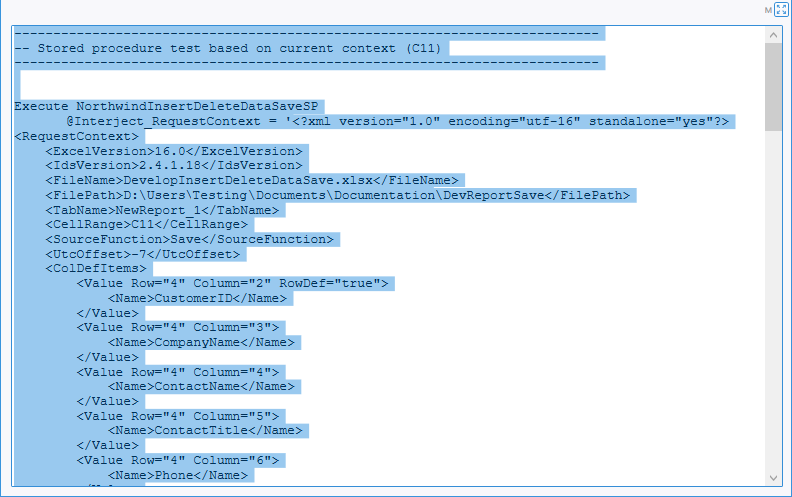
Paste the code into a new query and be sure to add the "@TestMode = 1" line to print out additional information about the SP process:
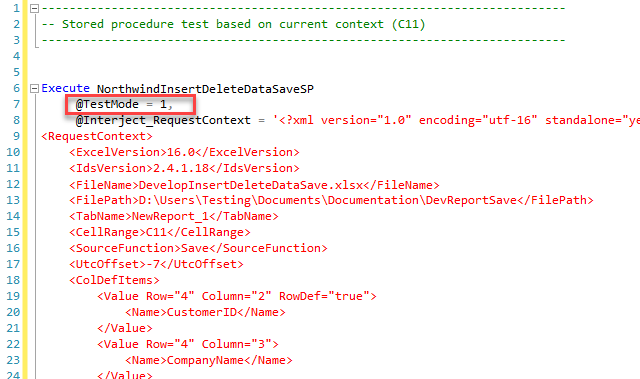
Make some changes to the data:
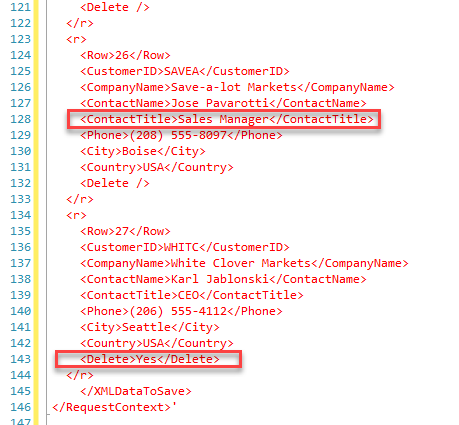
After execution, you should see the messages showing what was changed:
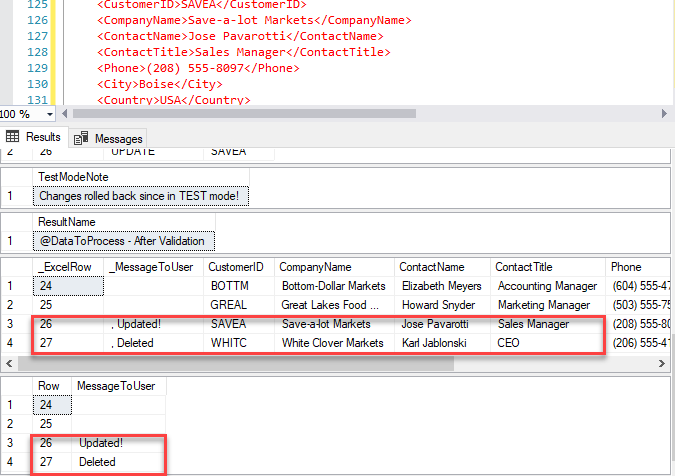
Testing the ReportSave
The only thing left to do is test the SP by running the ReportSave function within the Excel report.
Next make some changes and run the Report Save:

Notice the results!:
